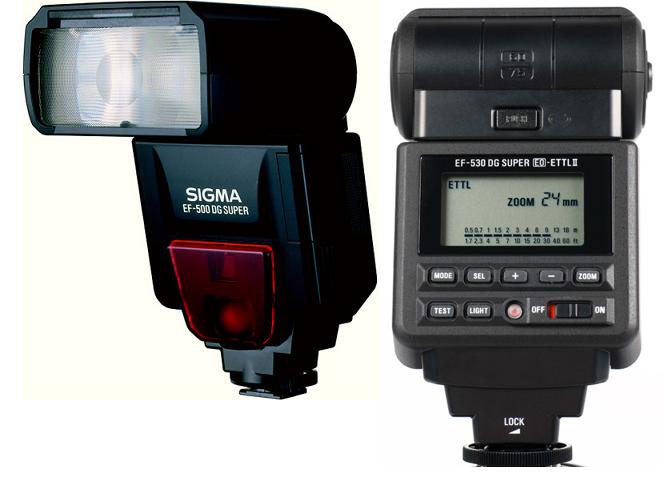Portable Flash Research
For this comparison I have chosen to compare Canon's 580EX II speedlite and the Sigma EF - 530 DG Super speedlite to equip with my Canon 7D.
Out of the two speedlites I would still prefer to buy the Canon branded flash as it is specifically made for the Canon camera equipment and software and it is a more powerful flash than the Sigma. If I didn't have the money to buy the 580EX II then I would go with the Sigma as it is still more powerful than the Canon 430EX II and just short of the 580EX II.
Here is a summery of what I have found.
 Canon 580EX II
Canon 580EX II
The 580EX II is a top of the line speedlite from Canon. This piece of equipment can be used as a Master to control slave units in multi-flash setups
using the built-in wireless (light-based) triggering system. The 7D can be used configure this flash directly from the in camera menus. Canon finally caught up to Nikon and
integrated this feature with the 7D's built-in flash. Other features include improved communication reliability through its
direct contacts, and recycling time is b
oth 20% shorter than the 580EX
and is completely inaudible.
Highlights
- Approximately 20 percent faster recycling time compared to 580EX
- Superior build quality, including a metal foot for higher rigidity
- Max Guide No. 58 at 105mm setting (GN 190, feet)
- Auto conversion of flash coverage with compatible digital SLR cameras
- White Balance info communicated instantly to compatible digital SLR cameras
- Full swivel, 180 degrees in either direction
- AF-assist beam, compatible with all AiAF points on every EOS SLR
- Dust- and water- resistance
Main Specifications:
- Guide Number: 24-58 (ISO 100, m)
- Flash coverage: 24-105mm (36-157mm)
- Recycling time: 0.1-6 seconds
- Bounce facility: Yes (0-90º)
- Swivel facility: Yes (0-360º)
- TTL: Yes
- AF assist beam: Yes
- Strobe flash: Yes
- Wireless flash: Yes
- Second-curtain sync: Yes
- Power source: Four AA batteries
- External power: Yes
- Dimensions (WHD): 76x134x114mm
- Weight: 375g
- Fitting: Canon
Cost: Unfortunately this speedlite has been discontinued by Canon and replaced by the 600 so there are few places left to buy a brand new 580EX II.
- Amazon - $699.00
- Ebay - $529.00
- Pro World - $646.00
- Top End Electronics - $693.91
 Sigma EF - 530 DG Super
Sigma EF - 530 DG Super
This Flash is compatible with Canon's TTL flash metering system. This flash is also
note worthy because while it is not as powerful as the 580EX II, it is
both cheaper and more powerful than the Canon 430EX II. Designed exclusively for Canon digital SLR cameras, the flash offers a
powerful guide number of 174 feet/53 meters and boasts the latest TTL
automatic flash exposure control for easy operation. More significantly,
the EF-530 is outfitted with a host of advanced features, including a
modeling flash function, a multi-pulse flash, a TTL wireless flash, an
FP (high-speed) flash, a rear-curtain synchro flash, and a manual flash
mode that allows the photographer to set the flash power level by up to
eight stops. The auto power-off function, meanwhile, automatically shuts
off the display to save battery power. And when the flashgun is fully
charged, the flash emits a confirmation-ready light, letting you check
the flash exposure level through the camera's viewfinder.
Highlights:
- Autozoom function that automatically sets the optimum illumination angle
- Covers a focal length from 24mm to 105mm
- A built-in wide panel that covers the 17mm angle
- A tilting flashgun head for bounce flash (up by 90 degrees, to the left by 180 degrees, and to the right by 90 degrees)
- A down tilt angle of 7 degrees for close-up photography
- Sophisticated multifunction flash that can control advanced lighting techniques
- Wireless slave-flash functions
- Measures 3 by 5.5 by 4.6 inches (W x H x D)
- Weighs 10.8 ounces
Third-party flashgun to fit Canon, Nikon, Pentax, Sigma and Sony
Main Specifications:
- Guide Number: 28-53 (ISO 100, m)
- Flash coverage: 16-70mm (24-105mm)
- Recycling time: 4-6 seconds
- Bounce facility: Yes (0-90º)
- Swivel facility: Yes (0-270º)
- TTL: Yes
- AF assist beam: Yes
- Strobe flash: Yes
- Wireless flash: Yes
- Second-curtain sync: Yes
- Power source: Four AA batteries
- External power: No
- Dimensions (WHD): 77x139x117mm
- Weight: 335g
- Fitting: Canon, Nikon, Pentax, Sigma, Sony
Cost:
- Amazon - $226.69
- Electronic Bazaar - $ 227.79
- Digital Camera Warehouse - $269.00
- Digi Direct - $484.00
Sources:













